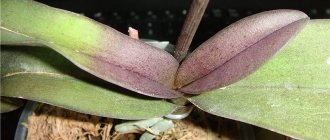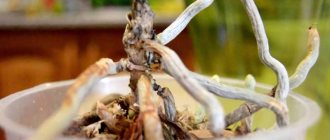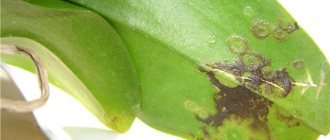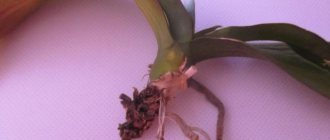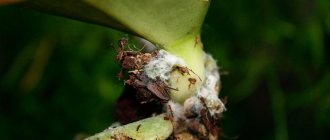Rot in orchids is one of the possible diseases that occurs mainly either due to improper watering or due to pest damage. Many are sure that the orchid is one of the most demanding plants to care for. But that's not true. It is enough to maintain comfortable conditions (temperature 22-26 degrees, humidity 40%-60%, illumination with soft diffused light for 8-10 or more hours) for the plant to enjoy health and abundant flowering. But even in this case, sometimes it is not possible to avoid the appearance of rot on the orchid.
Let's look at what diseases can affect a plant and lead to rotting of the leaves, stem or root system. In addition, we will talk in detail about what types of rot can appear on the plant and how to deal with them.
Signs indicating illness
If the epiphyte is healthy, then its roots are dense and smooth, and have a grayish-green color.
The following signs may indicate the disease::
The leaves became less elastic and became softer.- Darkening and drying of aerial roots.
- The plant became unstable and swaying.
- There is a coating of spores on the inner walls of the pot.
All these are early signs of putrefactive diseases of orchids. With initial resuscitation efforts, the flower can be brought back to life. But first it’s worth finding out why the orchid began to die.
External signs of black rot and development features
As a rule, a pathogenic fungus most often enters a plant through its roots. Afterwards it begins to spread throughout the rhizome, and then affects the ground part and leaves. With this disease, the ground part of the flower begins to wrinkle and harden, and the leaves become black and soft, and when pressed, liquid is released.
The danger of black rot is that the development of the disease begins in the place where the root system connects to the above-ground part of the plant. Therefore, without a thorough examination, it is quite difficult to detect the disease and most often the symptoms are noticed when the disease is already advanced.
When the first symptoms of black rot appear, you need to urgently take action and begin treatment . If the base of the above-ground part of the plant rots, then the orchid will no longer be able to be saved.
What parts of the plant may be affected?
Often the rotting process extends to the core, leaves or root system.
Leaves
Leaf rotting develops as a result of improper watering. Most often, orchid leaves are affected by the fungus Pythium . Typically, rotting begins at the base of the plant, after which the roots are affected. This process is rapid, the plant can die in literally 2-3 days. With Phytophthora fungus, the leaves become covered with brown dark spots. Wet rot inhibits plant development. High humidity and high air temperatures lead to this state of the flower.
At the base
If, during watering, water gets into the core of the flower (resembling a funnel), then with high humidity, high temperatures, poor lighting and other circumstances, the process of rotting of the trunk begins.
Rotting processes are most often caused by diseases such as fusarium rot, gray rot, leaf spot, powdery mildew, and viral diseases.
Root
The root rots due to improper watering . This is the main reason among all those considered. In second place is a rare orchid transplant. Old soil does not allow air to pass through to the root system, and moisture stagnation occurs there. And as a result, the root of the plant rotted.
We invite you to watch a video about what the affected plant looks like and what are the reasons for its infection:
Viral diseases of orchids: photographs and how to deal with diseases
Cymbidium mosaic virus (CyMMV).
This viral disease is extremely widespread among orchids and occurs exclusively in representatives of this family. In different genera of orchids, its symptoms manifest themselves differently. The disease is called black orchid necrosis, orchid mosaic virus, cattleya variegation, and so on.
On phalaenopsis flowers, this virus appears in the form of spots and stains that are paler than the color of the flower, randomly located on the petals and sepals. These stains appear especially clearly on flowers 1-2 weeks after the buds open.
On the leaves, this disease of domestic orchids begins with the appearance of small or larger shapeless pale green chlorotic spots, which then become necrotic. The spots can be located in the form of parallel black small strokes, rings, concentric circles, straight or curved lines located at an acute angle to the main vein of the leaf, and so on.
When combined with other viruses, spots of different types may appear on the same sheet. In orchids with thin leaves, the virus appears on the leaves 3-5 weeks after infection, primarily on young shoots.
Initially, chlorotic mosaic streaks and spots appear, which then become more clearly defined and darken. In older leaves, necrosis of the affected areas is observed. The intensity of growth and flowering is reduced.
On phalaenopsis leaves, the manifestations of viral infection are very diverse. These can be light green chlorotic spots, or deeply depressed necrotic, as well as weeping spots. Necrosis most often appears on the lower surface of leaves. Severely affected leaves die. Sometimes, however, external symptoms of a viral infection are completely absent even if the test for the presence of the virus is positive.
There are no effective measures to combat this orchid disease at home yet, so all diseased plants are destroyed.
Tobacco mosaic virus of orchids (TMV-O).
Tobacco mosaic virus (TMV) is often confused with tobacco mosaic virus of orchids (TMV-O), but the latter has a special nature and besides orchids it infects only a few indicator plants, while tobacco mosaic virus infects countless objects.
Most Tobacco Mosaic Virus (TMV) carriers do not infect orchids. The TMV-O virus often occurs together with other viruses.
There are no effective measures to combat viruses yet, so all diseased plants are destroyed.
Phalaenopsis mosaic virus (CyMV + TMV-O).
This disease is the result of a combination of two viruses - Cymbidium mosaic virus (CyMV) and Tobacco mosaic orchid virus (TMV-O).
Look at the photographs - with this disease, orchid leaves become covered with alternating light green or chlorotic spots:
The leaf tissues are destroyed: on the upper side the leaf blades become covered with chlorotic and necrotic spots, and on the lower side wide chlorotic grooves or weeping spots appear, and over time the spots become depressed.
There are no effective measures to combat viruses yet, so all diseased plants are destroyed.
Trichopilia virus (T1).
This virus was discovered in Germany in tropical epiphytic orchids of the genus Trichopilia. It appears in the form of continuous or dashed light and dark lines, arranged in a “fence” and running at an acute angle to the main vein of the leaf. There is no more detailed information about this virus.
The following is a description of bacterial diseases of orchids and tips on how to treat plants.
Photo
The photo shows what black and gray rot looks like on orchids.
Wet rot affecting fruits
Wet rot is a real scourge of orchards; it affects the fruits of many plants. First, a soft, fluid-filled area appears on the infected area of the fetus, which quickly increases in size. The entire fruit gradually softens and decomposes. If wet rot has affected the onion, then under 2-3 healthy scales you can find yellow-brown scales covered with mucus and emitting an unpleasant odor.
Wet rot often occurs due to mechanical damage to the fruit or a physiological disorder, such as poor pollination of the plant.
To prevent disease, the storage should be disinfected before storing onions. Harvesting should be done only in dry, sunny weather, after drying the harvested onions for 5 days in the sun. When trimming dry feathers, it is recommended to leave a neck 3-5 cm long. Onions should be stored in optimal hydrothermal conditions. To protect plants from wet rot, fruit should be collected carefully, avoiding damage.
After harvesting, the fruits should be cooled. As a preventative measure, they can be sprayed with a chlorinated solution. Fruits affected by wet rot should be destroyed.
What are the reasons?
Always at the beginning of putrefactive processes in an orchid flower, it is necessary to find out the reason for this circumstance. Then it will be clear what means to treat for black or gray rot.
There are several reasons for rotting:
- Lack of sunlight, when moisture evaporates poorly and water stagnates in the soil.
- Grinding the soil, due to this it becomes dense and heavy, in this case the moisture also evaporates poorly, the water stagnates.
- If the root area is damaged during transplantation, infection can penetrate through such wounds.
- Orchid infection by a fungal disease.
- Another reason why your flower began to rot is an overdose of chemical fertilizers when feeding the flower, as a result the plant receives a chemical burn.
- An attack on an orchid by click beetles that feed on the root system of the plant.
Often such problems occur in the autumn-winter period; it is at this time that it is important to reduce the number of waterings of the plant, but inexperienced gardeners continue to do this. As a result, the orchid rots.
Under natural conditions, the orchid grows in places with frequent tropical rainfall . Rainwater does not contain as many heavy elements and salts as are present in groundwater, and then flows out of taps in apartments.
Such water can burn the root system of orchids, as can too much chemical fertilizer.
As a result, the roots burn, and this causes rotting processes.
Description of the disease
Fungal microorganisms Pythium ultimum or Phytophthora cactorum are the causative agents of black rot, and water is the best environment for the development of their spores.
As soon as the affected moisture reaches the leaves, the pathogens quickly penetrate the tissues and continue active development. Through sap flow, they begin to affect other organs and most often move to the roots.
What to process?
Chemicals
How to treat an orchid, including gray and black rot, using chemicals? Often an orchid gets sick due to various pests . Chemical agents will help restore health to your favorite flower.
But you should not use these substances in too large quantities; they should be used carefully and within reasonable limits. You should try to choose drugs with a low (class 3-4) danger threshold.
When purchasing medicines for orchids, you should always follow the instructions that come with the product.
The most popular chemical preparations for plants are:
- "Fitoverm".
- "Inta-Vir".
- "Aktara".
- "Confidor".
More toxic substances that are used for serious diseases of orchids include:
- "Vertimek".
- "Karbofos".
- "Aktellik".
Folk
Traditional methods of combating orchid diseases can also be effective; it is worth considering the most effective of them.
Soap solution .
1 tbsp dissolves in 1 liter of water. liquid soap. Other options are also suitable - grated laundry soap or even dishwashing liquid. This solution treats the entire surface of the flower, especially the leaf parts.- Tobacco infusion .
30-40 g of tobacco is poured into 1 liter of water. The mixture should sit for 24 hours, and it should be stirred periodically. A day later, the tobacco liquid is filtered and the orchid is sprayed with it. - Onion infusion .
A small onion is rubbed through a grater, and the resulting mush is poured with boiling water. The product is left untouched for 7 hours. After this, you need to treat the plant with this mixture for 3-4 days.
Traditional methods
Folk remedies can also help save a sick flower. And here, experienced flower growers advise using cinnamon and garlic as measures to combat black rot.
The whole point is that cinnamon has high fungicidal properties. It is mixed with a small amount of vegetable oil and the resulting infusion is used to treat sections of the affected plant. Cinnamon not only heals wounds, but also creates protection against infection.
Garlic is known for its bactericidal properties. It is used for preventive purposes against black rot and other fungal diseases. To do this, prepare an infusion and water the flower directly at the root once a month.
Step-by-step instructions on what to do if certain parts of the flower are rotten?
Sheet
If rot appears on the leaves, this means that some problem needs to be eliminated. For example, in winter, remove the plant away from the battery.
But there should be enough daylight in the room. You need to check the orchid tray, perhaps moisture has accumulated there. Bordeaux mixture or fungicide is suitable for spraying leaves. Regular feeding with complex fertilizers for orchids is also important.
Root
What to do if the root of a plant begins to rot? You need to remove the plant from the pot and remove all dead and rotten roots. They can be recognized by their brown, gray or yellow tint. Diseased roots are cut off along the living part, otherwise the rot will begin to spread further. The cut areas are treated with brilliant green or activated carbon solution .
If most of the roots have been removed, then the plant is immersed in warm and well-filtered water. You need to change the water every day, and you need to dry the root well. The room itself should be well lit, and the air temperature should be within 25 degrees.
Trunk and peduncle
If the trunk and peduncle rot, how to save them?
The trunk and peduncle usually begin to rot earlier than other parts of the flower . Therefore, measures should be taken immediately. It is necessary to immediately treat the soil and root system with a 0.3% foundation solution or a 0.2% benlate mixture. Most often, the orchid is completely immersed in this substance. This is not done often, approximately every 2 weeks.
We invite you to watch a video about treating orchids for rot:
Prevention measures
Preventative measures are a necessity for any gardener who wants his orchids to delight with health and abundant flowering. So, follow these guidelines:
- Watering should be done exclusively under the roots. Try to prevent drops of moisture from getting into the leaf axils and on the flowers.
- If you are worried that rot may appear on the plant, you can place orange peels on top of the substrate. This is an excellent remedy for preventing disease.
- Provide the flower with proper nutrition. To do this, you should purchase exclusively specialized liquid fertilizers for orchids. Pay special attention to the nitrogen content. This substance is useful for orchids only if its percentage in the feeding does not exceed 14%-16%.
- Set up your irrigation system. It should be moderate. It is enough to water the flower once a week. In summer, you can increase the number of waterings to twice a week, and in winter, reduce them to once every 10-14 days. Avoid getting drops of moisture into leaf axils and flowers. You can spray the plant (as needed).
- The room where the orchid is located must be regularly ventilated. At the same time, prevent drafts from entering the plant.
- Regularly inspect the flower for damage or disease.
- Every two to three years, the orchid needs to be replanted to maintain the freshness and quality of the substrate. When it oxidizes, there is a high probability of problems with the flower.
- Make sure there is enough light for the plant - at least 8-10 hours of soft, diffused lighting.
- Wipe the vegetative mass of the orchid monthly with a weak antiseptic solution.
Now you know what to do if rot is detected on the orchid. Choose correctly how to fight and what to treat in order to save the plant. Remember that almost always an orchid of any variety (phalaenopsis, cattleya, ascocenda, vanda, cymbidium, dendrobium, etc.) can be saved if you act quickly. Take care of your plants so that they delight you with beauty, abundant flowering and health.
We save an orchid from root collar rotting in 4 stages
Rotting of the growing point (core) is uncommon. Most often this happens due to some kind of infection or prolonged stagnation of water. For the neck to begin to rot, water must remain there for at least a day. Sometimes purple dusty spots appear on the neck. This is a sign of fusarium, a fungal disease. You need to start treatment immediately, otherwise you will lose the flower:
- Using a sharp instrument, preferably a scalpel or a utility knife, you need to cut off the affected part, capturing 1.5–2 cm of healthy tissue.
- The sections should be sprinkled with crushed activated carbon or cinnamon. You can anoint it with iodine or brilliant green.
- Next, the sections need to be dried for about 20 minutes and planted in a dry, fresh substrate. The sections should not be wetted for a week.
- Before planting, the new substrate must be steamed and the plant sprayed with a fungicide. For example, "Fundazol". If wet bacterial rot occurs, you need to apply Bordeaux mixture.
There is no need to feed the plant after transplantation. The first feeding is done after 3-4 weeks with granules, which are placed in the substrate, or fed by leaf. The orchid must be treated with a fungicide for 2–3 weeks. Dilute and use the drug strictly according to the instructions. Place the pot in a dry, warm place. The duration of such treatment is 3 months and mandatory quarantine.
Preventive measures
Special equipment is required for pesticide treatment.
To prevent damage to crops by gray rot, it is recommended to strictly comply with all the agrotechnical requirements that are accepted in the region of cultivation. The main ones are the following:
- sprinkling the soil with wood ash;
- removing excess foliage from the plant;
- timely mulching of plantings;
- regular weed removal;
- spraying plants with Bordeaux mixture;
- selection of the most suitable plots in terms of site configuration (lighting, ventilation, etc.);
- cultivation of those orchid varieties that are characterized by resistance to botrytis and other fungal diseases;
- maintaining spatial isolation between plants in a row and between rows;
- compliance with crop rotation, in which an orchid cannot be planted twice in a row on the same part of the plot, etc.
Important! In order to detect the onset of disease symptoms in time, it is necessary to regularly visually inspect the plantings for the presence of gray spots and other damage.

